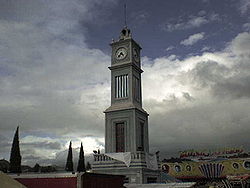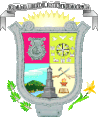Tlaxiaco
Tlaxiaco is a ceety, an its surroondin municipality o the same name, in the Mexican state o Oaxaca. It is locatit in the Tlaxiaco Destrict in the sooth o the Mixteca Region, wi a population o aboot 17,450. The ceety is formally kent as Heroica Ciudad de Tlaxiaco ("heroic ceety") in honour o a battle wagit thare durin the 1862–67 French invasion. Tlaxiaco [t͡ɬa.'ʃia.ko] is a Nahuatl name containin the elements tlachtli [t͡ɬ'at͡ʃt͡ɬi] (ball game), quiahuitl [ki'awit͡ɬ] (rain), an -co [ko] (place marker). It thus approximates tae "Place whaur it rains on the baw court". Its name in the Mixtec leid is Ndijiinu, which means "guid view".[1]
Heroica Ciudad de Tlaxiaco | |
|---|---|
 Monumental clock in Tlaxiaco | |
| Coordinates: 17°16′N 97°41′W / 17.267°N 97.683°W | |
| Kintra | |
| State | Oaxaca |
| Municipality | Tlaxiaco |
| Foondit | ca. 400 BC |
| Toun status | 1 October 1852 |
| Ceety status | 7 October 1884 |
| Area (municipality) | |
| • Total | 343.2 km2 (132.5 sq mi) |
| Elevation | 2040 m (6,690 ft) |
| Population (2005) | |
| • Ceety | 17450 |
| • Municip. | 34587 |
| Time zone | UTC-6 (CST) |
| Postal code | 69800 |
| Area code(s) | 953 |
| Fiestas | 14–21 October |
| Demonym | Tlaxiaqueño |
| Website | http://www.tlaxiaco.gob.mx/ |
The ceety
eeditThe ceety o Tlaxiaco staunds at 17°16’N, 97°41’W, at 2040 metres abuin sea level, some 180 kilometres tae the northeast of state caipital Oaxaca de Juárez. Tae the north the municipality borders wi Santiago Nundiche; tae the sooth wi San Antonio Sinicahua, San Miguel El Grande, San Esteban Atatlahuca, Santa Cruz Nundaco, Santo Tomás Ocotepec, an Putla Villa de Guerrero; tae the east wi Santa María del Rosario, Santa Catarina Tayata, San Cristobal Amoltepec, an Magdalena Peñasco; an tae the wast wi San Juan Mixtepec. The municipality covers a total surface aurie o 343.2 km².[1]
Tlaxiaco is locatit in temperate glen, surroondit bi twa muntains belangin tae the Sierra Mixteca: Cerro Negro an Cerro Yucuninu, the latter o which is the heichest point in the municipality at 2875 abuin sea level. Like maist o the Mixteca region, the Tlaxiaco glen is drained bi the Río Balsas seestem, which is fed bi numerous sma streams that rise in the hills near the municipal seat.
The climate is subhumid temperate, wi a rainy saison in the simmer. The average annual temperatur is 18 °C, awtho in winter temperaturs can drop tae zero or belaw. Unlike ither auries in the Mixteca region, the Tlaxiaco glen an its surroondin muntains still possess some conifer forests, inhabitit bi species includin deers, armadillos, rabbits, an ither sma mammals.
XETLA, a govrenment-run indigenous commonty radio station, is based in Tlaxiaco.
The ceety's Santa María Asunción kirk is notable for a nummer o colonial-era santos (statues o saunts).[2]
Notable Tlaxiaqueños
eedit- Lila Downs, sangster
The municipality
eeditAs municipal seat, Tlaxiaco haes govrenin jurisdiction ower the follaein commonties:
Agua Zarca, Arboleda, Atayiki, Barranca Obscura, Barrio San Miguel, Barrio San Nicolás, Benito Juárez Cuquila, Cañada Alejandro, Cañada Candelaria, Cañada del Curtidor, Cañada María (Primera Sección), Cañada María (Segunda Sección), Cabayoco, Campo de Aviación, Capilla del Carrizal, Cerrito de la Virgen, Cerro Negro, Colonia Adolfo López Mateos, Cruz Llorada, Ejido Cañada Santa María, Ejido Ojo de Agua (El Vergelito), El Apartadero, El Boquerón, El Capulín 1, El Capulín 2, El Crucero, El Mogote, El Ojite, El Sabino, El Terrero (Venustiano Carranza), El Vergel, Guadalupe Hidalgo, Ignacio Manuel Altamirano, Joya Grande, Juan Escutia Cuquila, Kilómetro Doce, La Angostura, La Barranca del Tabaco, La Corona, La Cruz Verde, La Desviación (Tierra Colorada), La Lobera 1, La Lobera 2, La Peña Negra, La Providencia, La Purísima Concepción, La Séptima Poniente, La Unión, Las Huertas, Linda Vista 1, Linda Vista 2, Llano Castro, Llano de Guadalupe, Llano de Plaza, Llano del Guajolote (Los Sánchez), Loma Aplastado, Loma del Venado, Loma Saayii, Loma Snuviji, Los Ángeles, Los Blancos, Los Cortés, Mexicalcingo de los Granados, Mogote de San Cristóbal, Nuñuma, Nueva Reforma, Ojo de Agua 1, Ojo de Agua 2, Palo de Letra, Plan de Guadalupe, Ranchería Santos, Rancho Viejo, Rancho Viejo (Eskandaba), Rancho Yosondua, Río de Arena, Río de los Pinos, Río de Ocotepec (Yutecuiñi), Río Delgado, San Agustín Tlacotepec, San Bartolo, San Diego, San Felipe Tindaco, San Isidro, San Isidro Mirasol, San Juan de las Flores, San Miguel Progreso, San Pedro, San Pedro Llano Grande, San Pedro Yosotatu, San Sebastián, Santa Lucrecia, Santa María Cuquila, Santo Domingo Huendío, Snite, Tierra Azul, Tierra Blanca (San Nicolás), Tierra Colorada, Yosobee, Yosocahanu, Yososana, Yosostato, Yosostuvi, Yosotica, Yosotium, Yucahua, Yucuhillo, Yucutu, Yutendoo, an Yutenino Segunda Sección.
The municipality reportit a population o 34,587 in the 2005 Census, o whom 9,399 spoke an indigenous leid (predominantly Mixtecan an Triqui).
The laund is essentially uised for habitation an sma-scale agriculture, which represents the main economic activity o the municipality's inhabitants.
References
eedit- ↑ a b Tlaxiaco Archived 2012-03-20 at the Wayback Machine (Enciclopedia de los municipios de México)]
- ↑ Santos in Oaxaca's Ancient Churches: Tlaxiaco Archived 2012-07-20 at Archive.today Retrieved 2012-04-16

